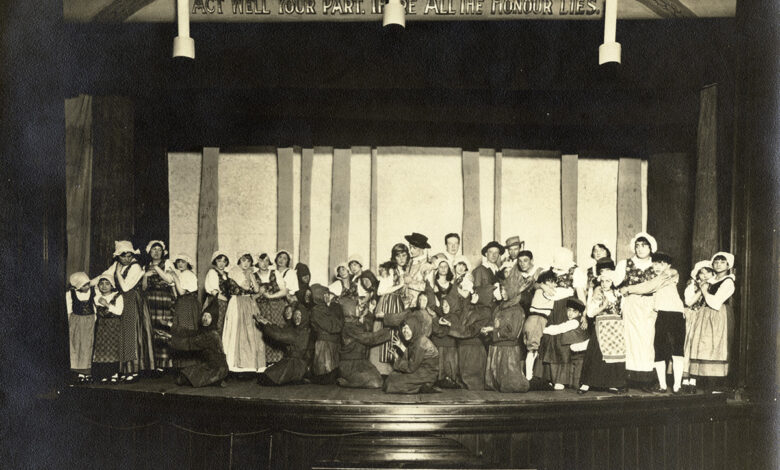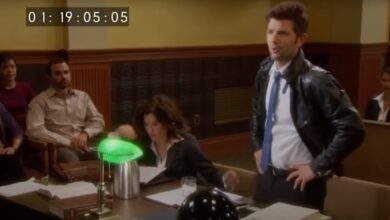Uncovering the roots of Chicago’s vibrant theater history

“Act Well Your Part, There All The Honour Lies” were the bold words etched on the fire curtain at Hull House Theatre—a quote borrowed from Alexander Pope to inspire actors to connect their art with the civic engagement that Hull House famously wove into every aspect of their outreach. Chicago theatermakers and theater lovers were present on April 14 for the opening of a new festival and exhibit aptly named after that motto at Jane Addams Hull-House Museum, designed to connect today’s performing arts scene with Hull House’s influence.
The opening panel discussion featured a who’s who of theater influences, including Mikhail Fiksel (resident composer and sound designer at Albany Park Theater Project), Marti Lyons (artistic director of Remy Bumppo), Wendy Mateo (producing artistic director at Teatro Vista), Gabrielle Randle-Bent (senior artistic producer at Court Theatre), and Malkia Stampley (Bold artistic producer at Goodman Theatre). Guided by questions from moderator and Hull-House associate director Matthew Randle-Bent, they spoke eloquently about the work each of their theaters was doing to ensure that the social impact and activism Hull House Theatre established in Chicago beginning in 1899 continues to have a meaningful impact today.
“Act Well Your Part”
Ongoing exhibit: Tue–Fri 10 AM–4:50 PM, Sun noon–4:50 PM, Jane Addams Hull-House Museum, 800 S. Halsted, www.hullhousemuseum.org/act-well-your-part-there-all-the-honour-lies, free
Hull House, one of the first settlement houses in the United States, was founded by Jane Addams and Ellen Gates Starr in 1889 in a mansion once owned by real estate developer Charles Hull. The organization engaged primarily with immigrants and the working poor, providing the kind of community care many nonprofit institutions aspire to today. Among the many services they offered were free childcare, health clinics, youth programming, language classes, employment assistance, and legal aid.
Before ceasing operations as a nonprofit in 2012, Hull House helped secure important social gains for Chicago residents and set a precedent for social services around the country. They fought for child labor laws, helped establish social work as a profession, fought for women’s suffrage, and pushed to establish labor unions. Thanks to the visionary leadership of Addams and company, Hull House took a holistic approach to community building, focusing on work–life balance while the forces of industrial expansion and capitalism treated the immigrant population simply as an expendable labor source. By including artistic activities (like arts and crafts, music, and theater) side by side with social services, Hull House became a true cultural hub to the community, rather than merely a service-providing institution.

The festival celebrates this legacy with a deeper look at the impact of Hull House on theater arts. Ross Stanton Jordan, Hull House’s curatorial manager, describes the goal for the festival’s first year. “We want to reach people who are engaged in civic projects around Chicago . . . who are interested in the history of the city of Chicago.” Jordan says they often give tours to high school students and senior citizens who are committed to social change and civic engagement, but who often don’t understand how Chicago’s theater history piece fits into the puzzle. “Those people are like the Jane Addams [of] today, who are trying to make their lives in service of other people.” But Jordan notes they want to broaden their reach to wider communities as well.
Matthew Randle-Bent credits Hull House as an early adopter in getting theater out of the Loop and into neighborhoods—something we see reflected in the dozens of storefront theaters around town.
Lakeview’s Hull House theater program, under the direction of the legendary Robert Sickinger from 1963–69, produced local premieres by Edward Albee, Harold Pinter, Athol Fugard, and Amiri Baraka (previously known as Leroi Jones) as well as bold reimaginings of classics. Before being gutted in 2002 to make way for a health club, the venue at Broadway and Belmont provided a home for several Chicago companies at various times, including Steppenwolf, Famous Door, Bailiwick Repertory, and About Face Theatre. The Uptown Hull House Center was home to Stuart Gordon’s highly influential Organic Theater Company, before becoming a home for Black Ensemble Theater, and finally for Pegasus Players (now Pegasus Theatre Chicago). It closed permanently in 2013, despite a last-minute attempt by Gordon and friends to save the building.
“The idea that you can coax really notable, excellent performances out of amateur actors? That was just a working assumption that Jane Addams had.”
Liesl Olson
Randle-Bent notes a trend over the past five years of theatermakers using the performing arts as a bridge to connect their overlapping missions. “I see Teatro Vista partnering with Steppenwolf. I see Wendy Mateo directing at the Goodman next year. [Mateo is slated to direct Marco Antonio Rodriguez’s stage adaptation of Junot Díaz’s The Brief Wondrous Life of Oscar Wao at the Goodman in winter 2026.] Here are big institutions that are cooperating with midsize or small institutions to make interesting work.”
Museum director Liesl Olson reflects on additional ways Hull House impacted the enduring Chicago “little theater” movement: “The idea that you can coax really notable, excellent performances out of amateur actors? That was just a working assumption that Jane Addams had. You can have the Greek community performing The Return of Odysseus. . . . And when Bob Sickinger comes in the 60s, he has open casting calls across the city.”
That same impetus today drives midwest teens and college kids to move to Chicago to conquer the stage, often with grassroots programs where they mingle with actors of all ages from around town. For example, the Berger Park drama program, run by director Eileen Tull, regularly offers acting and directing classes at low cost and runs camps and shows year-round. They’re about to launch a site-specific world premiere of a show set in the midwest titled The Ostrich, coproduced by the Terror Cottas and featuring all local talent.
The exhibit
The theater exhibit was activated opening night of the festival and will run concurrently with the ongoing exhibit “Radical Craft.” A stroll around the dining hall lets visitors peer at photos, playbills, and colorful re-creations of posters dating back to the theater’s start. Olson says opening the dining hall to the public for the festival and exhibit itself is meaningful, since it has rarely been used as an exhibition space: “It was where the social reformers stopped every day, had a meal, talked about what they were up to and shared ideas.” Circling those hallowed halls surrounded by images from Hull House Theatre enables visitors to virtually time travel back to an earlier era with similar social problems and solutions.

A photo on display shows Viola Spolin and her then-young son Paul Sills on stage with a group of children. Cofounder of Second City and an early pioneer in improvisational theater, Sills was inspired by the theater games his director mother created for the children of Hull House (which are still foundational to improvisational training today). One moving set of images is a series of negatives that document Mary Alice Smith’s performance in In White America for the Hull House touring theater in 1966, a factual play exploring the Black American experience throughout history.
The festival
Candace Bey, social historian and cultural educator at Hull House, connects the dots in an interview between the festival programming and Chicago’s heritage as a great theater town. The upcoming communal arts activation Books and Banners of the People (April 26), led by Court Theatre and Silvia Inés Gonzalez, will draw on the themes in Mickle Maher’s play Berlin (based on the graphic novel by Jason Lutes) of resistance in times of political strife and fascism.
At D-Compressed: Activating the Archives of Black Hull-House Theatre, which took place on April 18, Chicago theater artists Cheryl Lynn Bruce and Ericka Ratcliff led a night of meditation and music celebrating the work of Black composers and theater artists, featuring a performance by the Black chamber music collective D-Composed.
Bey mentions recognizing legacies, like the work done by the Experimental Black Actors Guild (a south-side theater company where actor and filmmaker Robert Townsend worked in the 1970s) and underground Black artists. She says, “It makes me think about that period after theater leaves this site and moves into neighborhoods, and how that neighborhood-specific work continues.”
“You have to have theater in your community. It’s essential.”
Ross Stanton Jordan
Subsequent events in the festival will include a conversation about the kinds of work Hull House did in the 1960s featuring Matthew Randle-Bent, Olson, and Chicago theater historian Mark Larson (April 27); two performances by the Neo-Futurists’ eternally morphing show The Infinite Wrench (April 30 and May 1); and a culminating conversation (May 7) about a century of design called Act Well Your Part, Designing Hull-House Theatre.
The curation process itself was just the sort of challenge the team at Hull House enjoys, involving a citywide exploration of archives and papers and hours of perusing the special collections at Harold Washington and Newberry libraries and at the University of Illinois Chicago. It involved the sleuthing skills of the entire Hull House team, including Bey, program assistant Cecilia Rossi, intern Ximena Ramirez, and curatorial assistant Fabrizzio Subia, all of whom dug up the scattered gems visitors can now see on display throughout the museum.
Jordan wants the Chicagoans of today to know the elemental message that their deep research has uncovered in the archives—something that people used to understand about the power of theater. “It was as equal and as necessary as clean drinking water and living wages and unions. You have to have theater in your community. It’s essential.” He worries that our culture, leaders, and people have lost sight of that. “We’ve all inherited this history. Even if we don’t know it, we benefit from it, and our job as a museum is trying to just sift through the sand and bring up some of the key things that provide some inspiration.”
https://chicagoreader.com/wp-content/uploads/2025/04/f_web.jpg
2025-04-22 15:51:03










